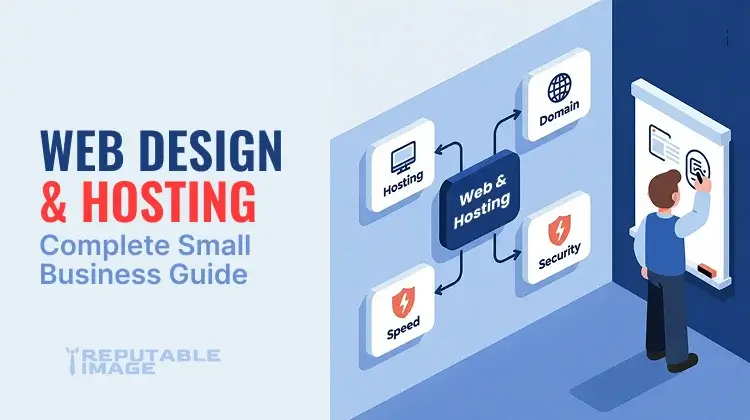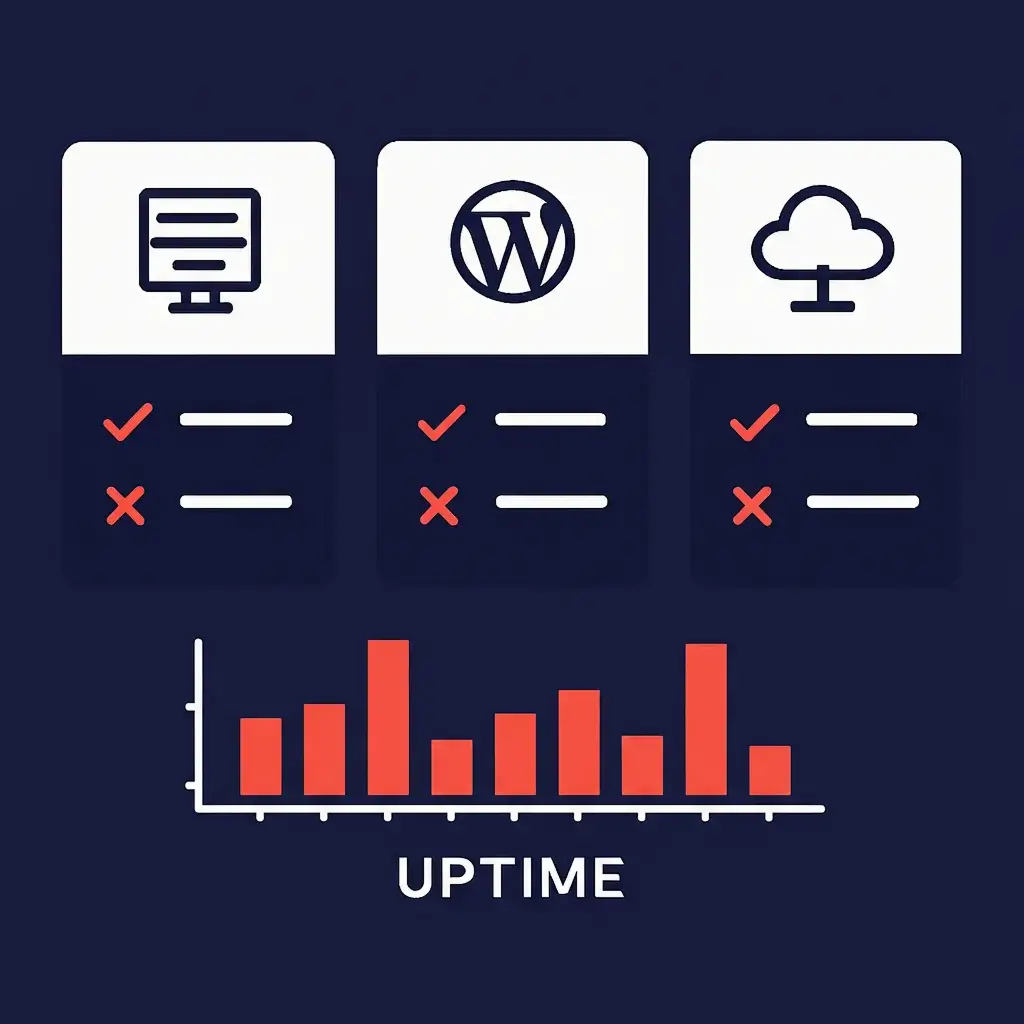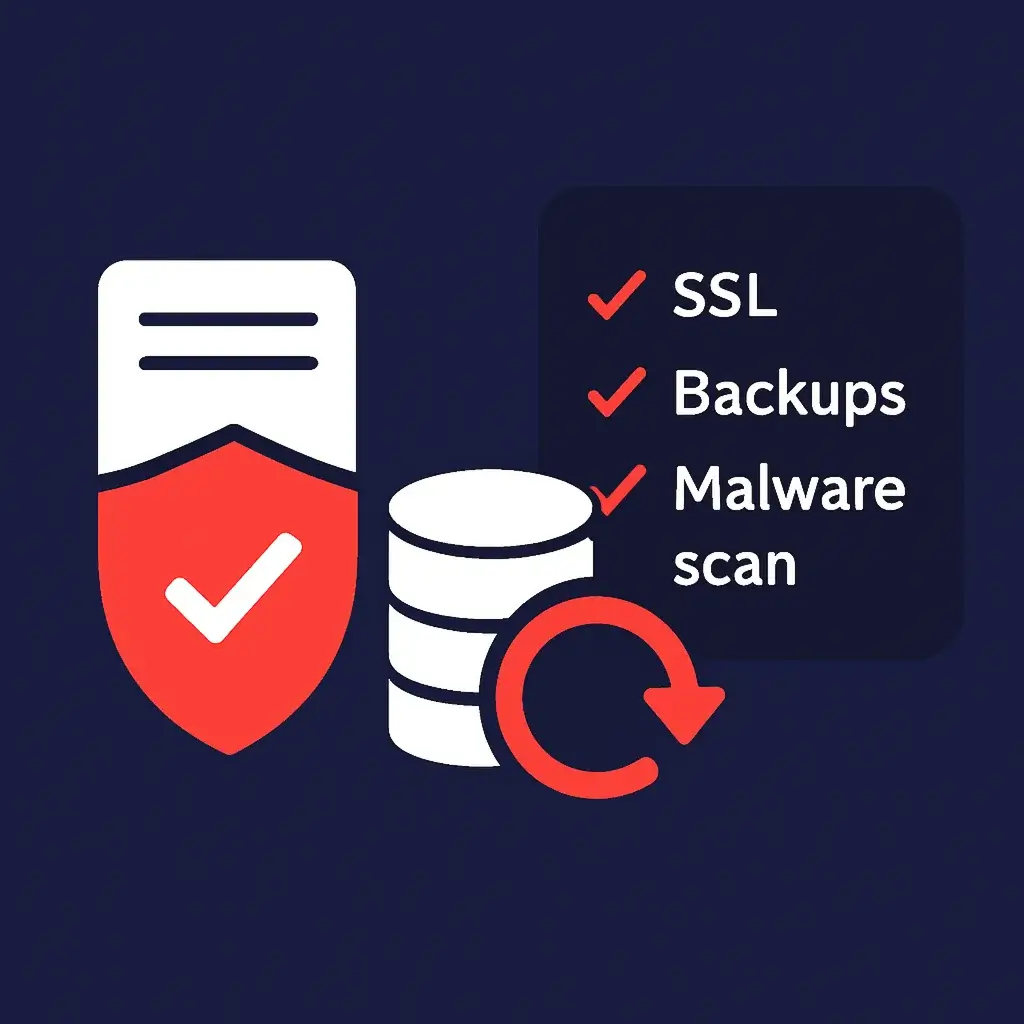
Web Design & Hosting:
Complete Small Biz Guide
Web design and hosting choices determine whether your small business site attracts visitors, converts them, and scales as you grow. Pick the wrong hosting or a bloated theme and your site will feel slow and unreliable; choose wisely and your website becomes an engine for leads and sales.
This guide walks through practical decisions — how to choose hosting (shared vs managed vs VPS), pick a domain, speed up pages, secure your site, and set up a maintainable CMS and workflow. Each section ends with quick actions you can take or hand off to a developer.

How to choose the best hosting for small businesses (shared vs managed vs VPS)
Shared hosting is the cheapest way to get online and is fine for basic brochure sites with low traffic, but it comes with noisy neighbors and limited resources. Use shared when budget is the main constraint and you expect only light traffic; expect slower response times under load.
Managed WordPress hosting adds automated backups, security hardening, staging environments, and platform-level performance optimizations — it’s a great tradeoff for small businesses that want low-maintenance reliability. VPS or cloud hosting gives you dedicated resources and more control, which is better when you need custom server-level configuration, higher performance, or predictable scaling; factor in higher cost and maintenance needs.
Domain selection:
SEO-friendly domain tips and common pitfalls
Choose a domain that’s short, brandable, and easy to spell aloud — avoid hyphens, long words, and numeric substitutions that confuse customers. While exact-match keyword domains used to be an SEO hack, today a clear, memorable brand domain plus smart on-site signals is a more defensible choice.
Consider registering common misspellings or local TLDs to protect your brand and redirect them to the canonical domain. Always configure HTTPS from day one and set canonical tags and 301 redirects properly if you keep variants.

Site Speed Checklist:
images, caching, and CDN
Speed matters: faster pages increase engagement and conversion while slower pages lose visitors and rankings. Start by measuring LCP, INP/FID, and CLS with Lighthouse or WebPageTest to get a baseline and prioritize the biggest wins rather than chasing every micro-optimization.
Optimize images (resize, compress, WebP/AVIF), enable server-side caching and long cache headers for static assets, and use a CDN to reduce latency for distributed audiences. Small changes — compressing your top 5 hero images or enabling host caching — often yield the biggest perceptible gains. For a step-by-step checklist and tools to run immediately, see Site Speed Checklist: Images, Caching & CDN.
WordPress vs headless vs site builders:
which fits your business?
WordPress is flexible and has a massive ecosystem of plugins and themes — it’s a strong choice for content-heavy small business sites where non-technical editors publish regularly. Site builders (Squarespace, Wix, Shopify) offer fast setup and fewer maintenance needs, ideal for DIY owners or simple stores; migration can be harder later.
Headless or Jamstack approaches provide speed and scalability by decoupling content from presentation, but they require developer resources and more complex deployments. Choose based on who will maintain the site, expected traffic/feature needs, and your willingness to invest in development.
Mobile-first design:
best practices and testing checklist
Design mobile-first by prioritizing the most important content and CTAs for small screens: make forms short, buttons large enough to tap, and headlines scannable. Test on real devices and through throttled network simulations to capture real-world performance differences, not just desktop metrics.
Ensure responsive images and layout shifts are minimized (reduce CLS) and make the mobile navigation simple; mobile users often have a task-oriented intent, so streamline the path to conversion.

Security basics:
SSL, backups, malware scanning, and incident response
SSL/TLS is non-negotiable — HTTPS protects user data and is expected by browsers and search engines. Combine SSL with daily automated backups (plus one off-site copy) and malware scanning to detect issues early; always test your backup restores so you know they work when needed. Keep your backups and updates predictable — see our Regular Maintenance for Small Business Sites checklist.
Have an incident response plan: isolate the site (maintenance page), restore from a clean backup, rotate credentials, and scan for backdoors; after recovery, patch the vector and monitor for re-infection.
Core Web Vitals explained (LCP, INP/FID, CLS) and how to improve them
Core Web Vitals measure user-perceived performance: LCP (how fast the main content loads), INP/FID (interactivity), and CLS (visual stability). Improving LCP often means optimizing images and server response; INP/FID improvements require reducing main-thread blocking JS; CLS fixes need stable dimensions for images and ads.
Track these metrics in both lab and field (Lighthouse + CrUX) and set a performance budget so regressions trigger review in your release workflow.
Site structure & URL planning for SEO (sitemaps, canonical tags)
A logical site structure with shallow depth and descriptive URLs helps both users and search engines find content quickly. Use clear folder structures (e.g., /services/web-design) and avoid long query-string driven pages for primary content; submit an accurate sitemap and use canonical tags to prevent duplicate-content issues.
Plan your navigation and internal linking around primary services and pillar pages so authority flows to the pages you most want to rank.
Choosing a CMS for content teams:
editorial workflow and permissions
Pick a CMS that matches your editorial workflow: you’ll want drafts, scheduling, roles/permissions, and media management out of the box for small teams. WordPress and many headless CMSs support robust editorial workflows; site builders may be fine for solo owners but often lack fine-grained roles.
Consider integrations (email, CRM, analytics) and how easy it is to move content between staging and production — the CMS should make content publishing safer, not riskier.
How to run a site audit:
tools, metrics, and quick wins
A site audit starts with three pillars: performance (LCP/TTFB), technical SEO (crawl errors, redirects, sitemap), and content quality (thin pages, keyword cannibalization). Use Lighthouse, Screaming Frog, and GA4 to collect data, then rank issues by impact and effort — prioritize fixes that improve conversions and uptime.
Quick wins include fixing broken links, compressing large images, enabling caching, and adding missing meta descriptions on high-traffic pages.


